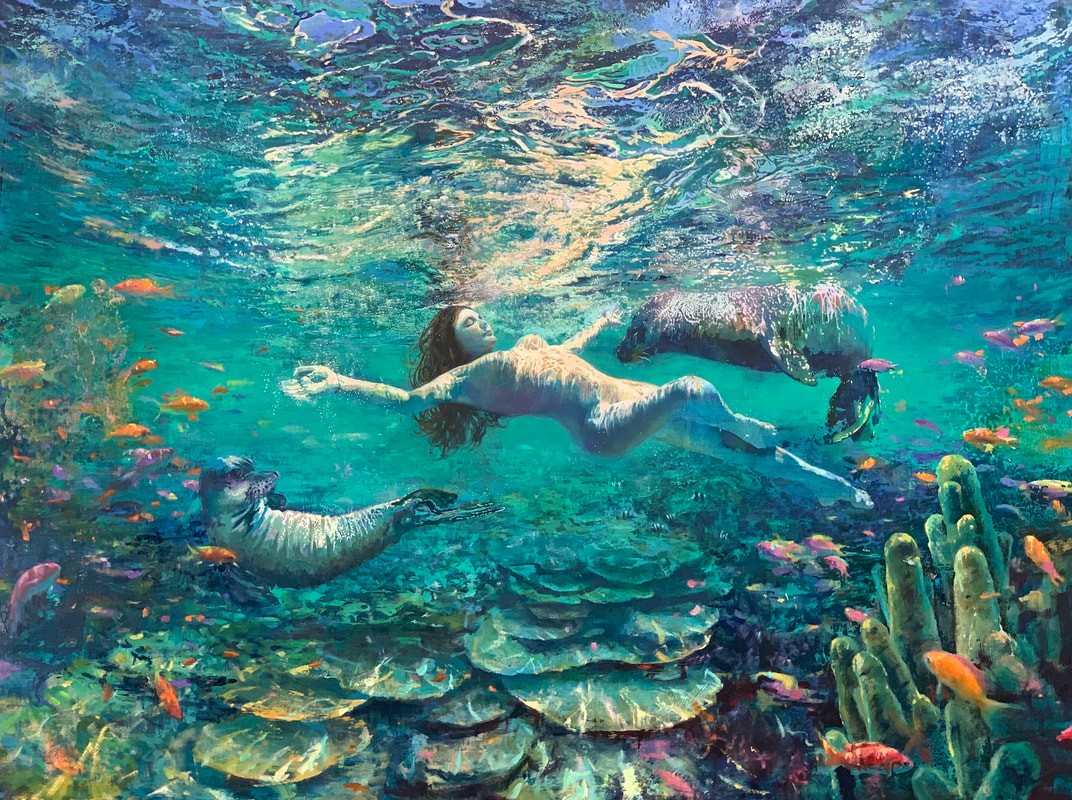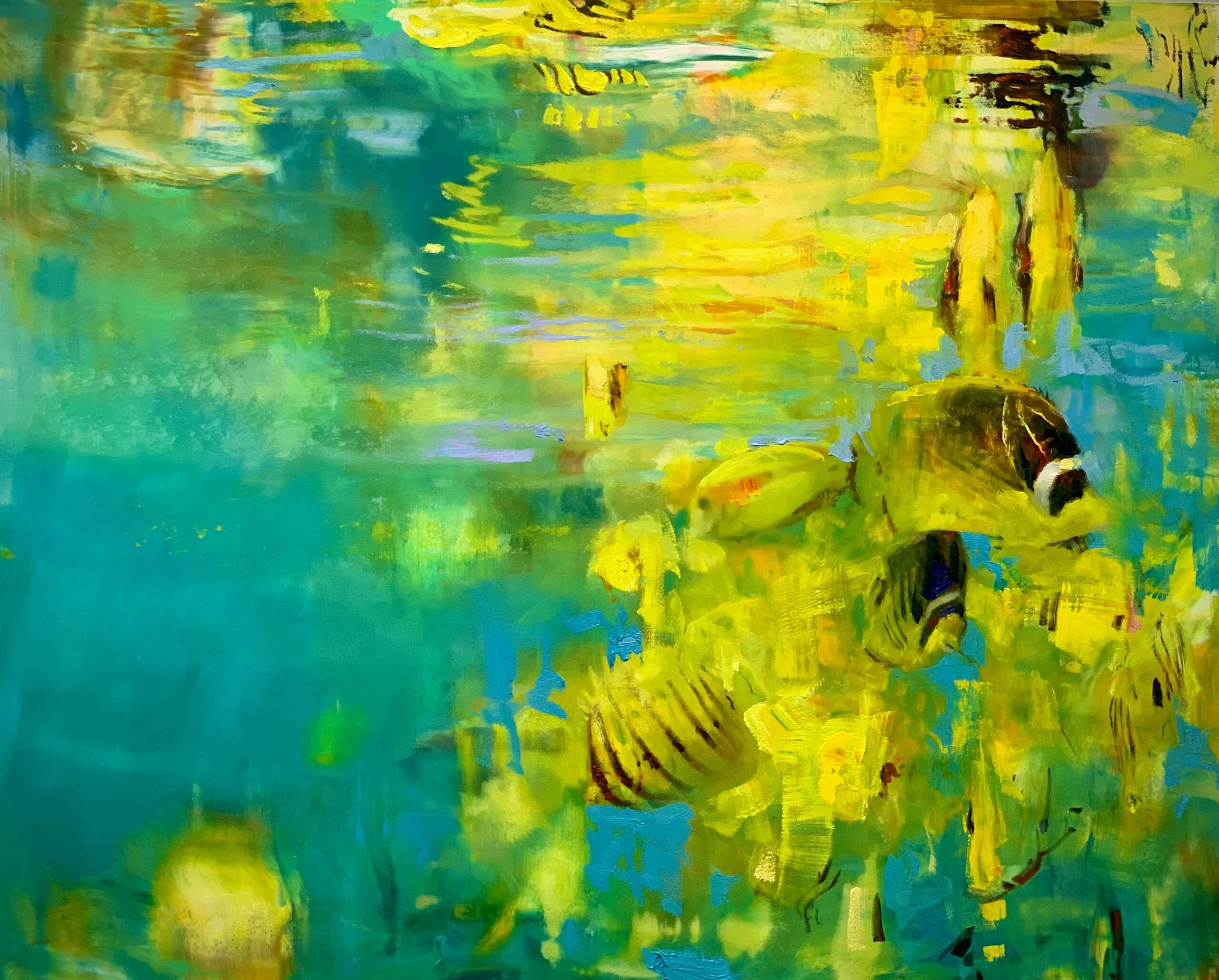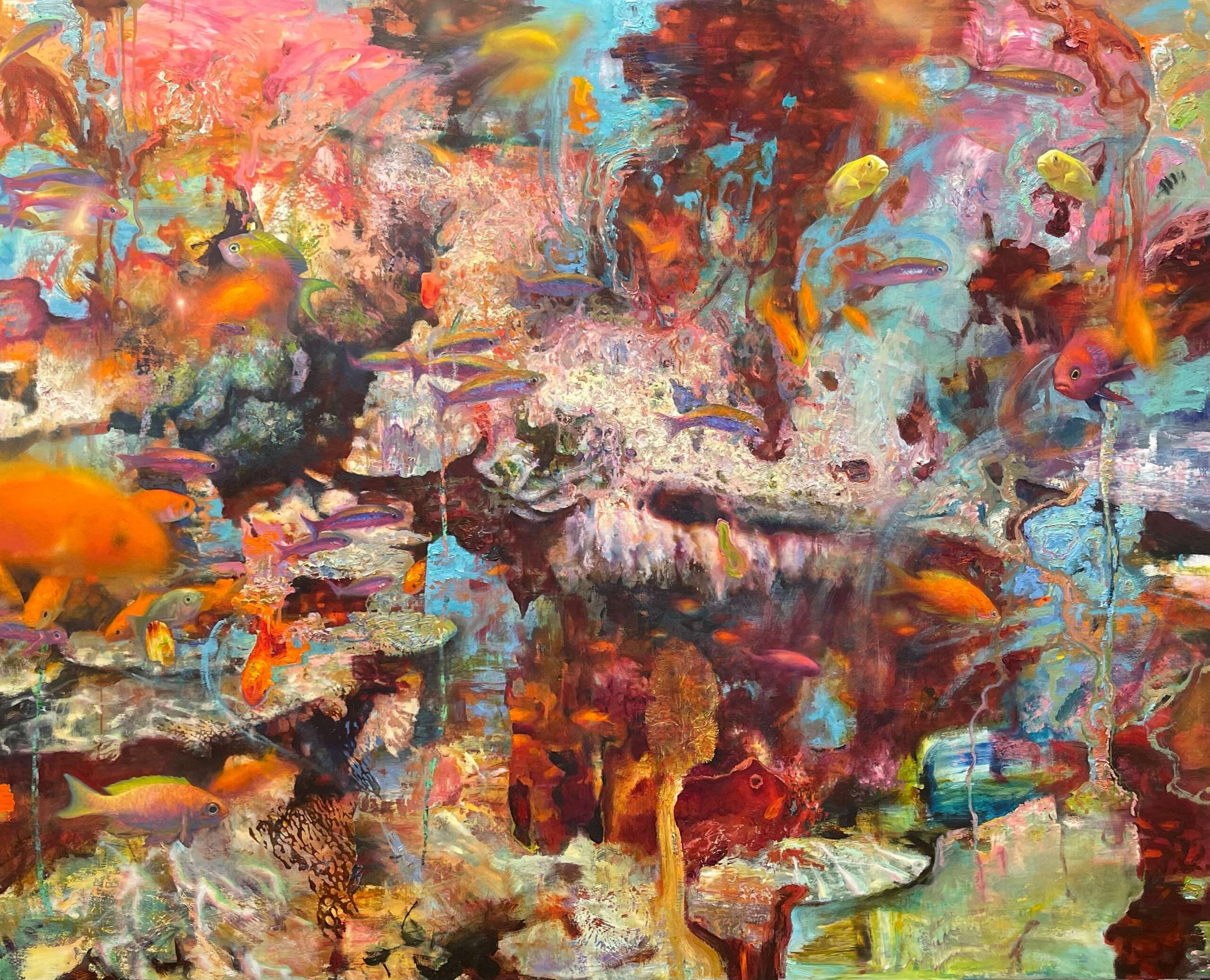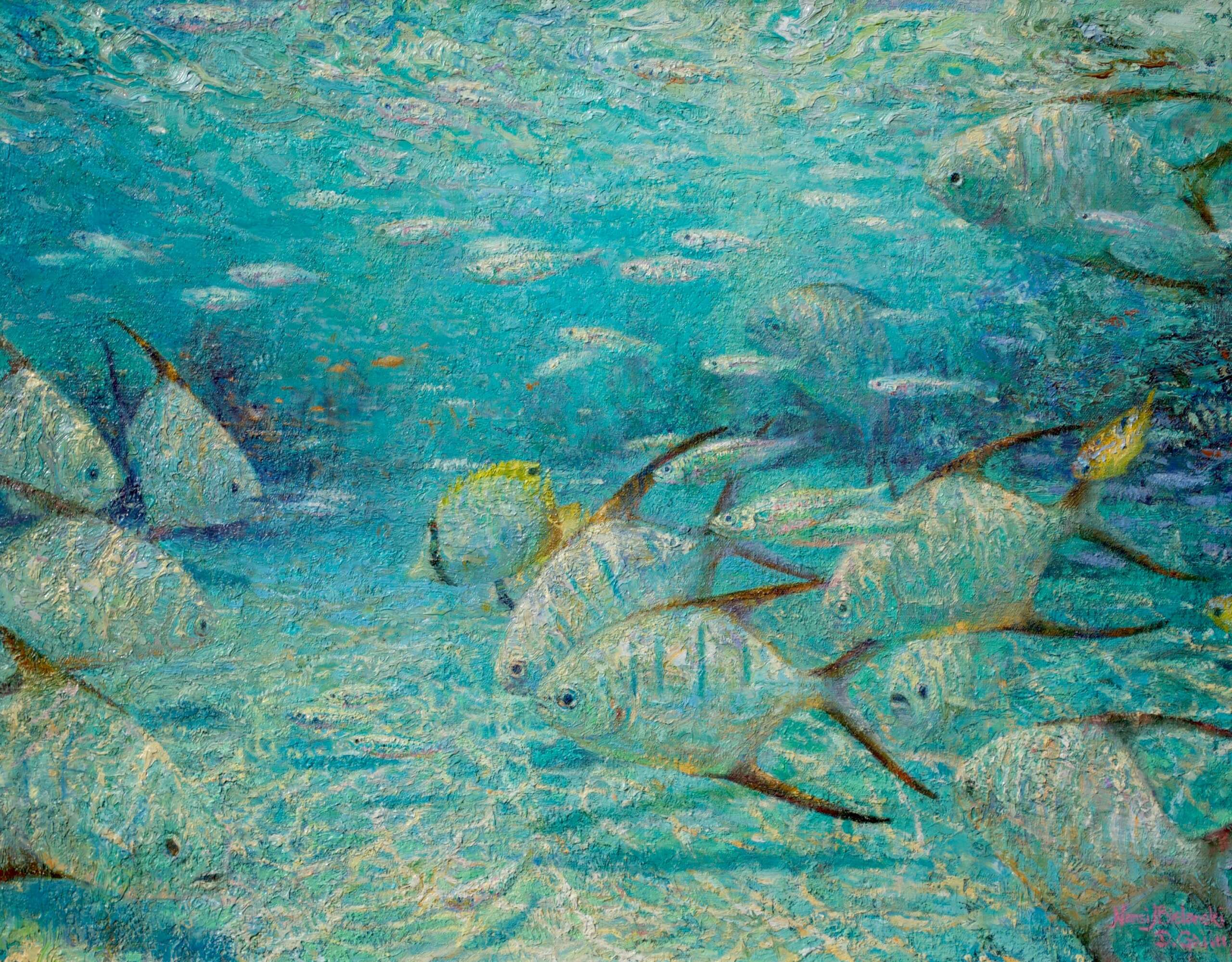We recently connected with Nansi and David Gallup and have shared our conversation below.
Nansi and David , appreciate you joining us today. We’d love to hear about a project that you’ve worked on that’s meant a lot to you.
Our paintings came first from a love of painting, and then our passions naturally began to take hold of the canvas. As SCUBA enthusiasts, we have been traveling the world together for over a decade, and independently before that. Having seen firsthand the indescribable beauty of a thriving coral reef, how could we not be inspired to try to paint the experience?
Painting underwater scenes is a phenomenally challenging discipline. Cameras need artificial light to work in all but the most shallow depths giving a very camera-centric view of life underwater, while working directly from life is also impossible. In these paintings, not only do we have to conquer all of the ordinary challenges in a painting (drawing skills, design, brushwork, etc.), but we also have to do it from memory and imagination. Also, we’re trying to create something new on a canvas, something we’ve never seen before.
Working closely with coral reefs and the animals who call them home, we began learning about what makes these reefs so beautiful, and so important. For example, we learned that up to 90% of the world’s coral reefs could be gone or severely damaged by human activity in the next thirty years due to global climate change and overfishing. We also learned that if we work together across national and ideological boundaries there is still time to make sure these reefs are a healthy and useful resource for future generations.
It is with all of that in mind that we have dedicated our work to inspiring coral reef conservation, and to spreading the word about the need to conserve this resource before it’s too late. We have spent a decade now finding a style for our work which is contemporary and personal, as well as honing our message and educating ourselves about what can, and must, be done.
The resulting and ongoing body of work will be officially introduced to the world this Fall at the California Nature Art Museum in Solvang, California. The two of us will be exhibiting approximately forty paintings in the main gallery for six months, and we’re publishing a book about our paintings to accompany the exhibit. After that show is over, our exhibit will travel to the new ICONIC Museum in Texas, and then we hope to continue touring the paintings around the world. This work is our way of doing what we can to educate the public about the need for all of us to pay attention to the health of our oceans and coral reefs, upon which we all depend.


Great, appreciate you sharing that with us. Before we ask you to share more of your insights, can you take a moment to introduce yourself and how you got to where you are today to our readers.
The two of us have known one another as colleagues for over twenty years, with a romance blooming just over a decade ago. David’s work comes from an academic realism background with a love of landscape and wildlife, and Nansi’s work was more inspired by contemporary figurative work and Modernism. As we began to dive together, we began to paint together. Nansi’s boldness and passion informed and deconstructed David’s more meticulous approach, new philosophies were born, and over time we innovated a new style of work which we call “Experientialism”.
By doing away with most of the academic rules about perspective (the idea that a subject is best represented on canvas from one exact place in space and time, as a camera might see) and painting instead from memory and imagination, we found a way to incorporate aspects of academic painting and realism as they might be applied to a memory. We are not looking for answers in our work, but rather exploring questions: “What does a memory look like?” “If motion and time are critical elements of human perception, how can that be conveyed in fixed paint on a two dimensional surface?” “If we took all of our favorite elements from every style of painting throughout art history, could they be woven successfully into a new style, and could we make that style work in an underwater setting?”
This is how we spend our days, exploring these questions together on canvas and exploring the oceans in search of more experiences and inspiration. It is a romantic and fulfilling way to live, but it takes courage and dedication, every day. Courage to decide to make our lives match our dreams, and dedication to make those dreams a reality.


What do you think is the goal or mission that drives your creative journey?
During the Covid isolation of 2020, the two of us began looking for a second studio. Our home/studio is in Southern California near Ventura. It is in a great community and we love the opportunity to be surrounded by so many amazing artist in the area, but we are a long way from our preferred subject. Because cameras aren’t a great option for capturing inspiration underwater, we started looking for a second studio where we could work directly from fresh inspiration: a small island on a coral reef with a studio just footsteps from the beach.
After spending much of 2020 researching islands from a logistical, political and real estate perspective we narrowed down our list and went looking. in 2022 we visited Molono Island in Vanuatu, an emerging nation in the Coral Sea, and we knew we were home. At almost five acres, it’s just the right size for one romantic, adventuresome couple. When we’re here in California, we will offer Molono as a romantic experience for like-minded travelers who want to spend time alone on a little slice of tropical paradise. When we are there, we can have a morning swim before picking fresh bananas and papayas to share over our morning coffee on the beach, and paint all day.
Having this opportunity has put us in close touch with the people of Vanuatu, and we are completely in love with them. Their willingness to help one another and engage with their communities is a dramatic change from the polarized, consumer-driven, social media-obsessed contemporary American experience we find too often at home. The way they welcome and look after strangers and immigrants (like us) should be a lesson for the world. We may have some things to teach the populations who inhabit the South Pacific Islands, but we have much, much more to learn from them.
Approximately One Billion People rely on the reefs daily for food and income opportunities, and they are some of the world’s poorest. While they have been impressively conscientious in their caretaking of this resource, their reefs are beginning to suffer from what we in the developed world are doing in ignorance. Rising sea levels have made some islands uninhabitable, sending families fleeing their ancestral homes for bigger islands and into cities. The global appetite for shark fins is destabilizing their ocean ecosystems and hurricanes are becoming stronger due to climate change. The coral reefs, historically bountiful and dependable sources of food and income, are showing signs of stress everywhere. If we are to ward off a human-caused humanitarian crisis in the South Pacific, people from around the developed world must engage soon, and that’s where art can be part of the solution.

Do you think there is something that non-creatives might struggle to understand about your journey as a creative? Maybe you can shed some light?
One thing we find is a common source of wonder for non-painters and painters alike is the idea that two artists would collaborate on one canvas. Indeed, examples of painters working together on one painting are scarce. If we think of a painting as the manifestation of one human’s ego, that makes sense. But what if we look at painting like songwriting, film-making, or just about any other kind of art? Now opportunities to enjoy the process as a couple begin to reveal themselves, and the way forward is natural when egos are put aside for the good of the painting.
Both of us are capable of making good and accurate marks, so it matters little whose hand is holding the brush. Most of the real work of creating a painting is conceptualizing a scene, figuring out a design that is original and engaging, and applying a particular philosophy to the intended experience of the viewer. These things, as it happens, are best solved in conversation. Our collaborative works, then, are not manifestations of one person’s ego, but the result of questions and conversations we have in the studio about what a painting might achieve, or what we as a couple might contribute to the life of the viewer based on our unique backgrounds and insights.
There is a very real danger in collaborative art of getting “art by committee”, a watered-down lowest-common-denomenator version of a painting. When the two of us collaborate and discuss, we often find we have different ideas on where a painting should go. We make sure not to find a solution in-between our two inclinations, but instead work to find a third solution that neither of us had considered. In this way, we strengthen the painting rather than weakening it. We favor the most controversial and bold decisions over traditional and safe ideas, pushing both artists to delightfully uncomfortable new places.

Contact Info:
- Website: www.gallupcontemporary.com
- Instagram: [email protected]


